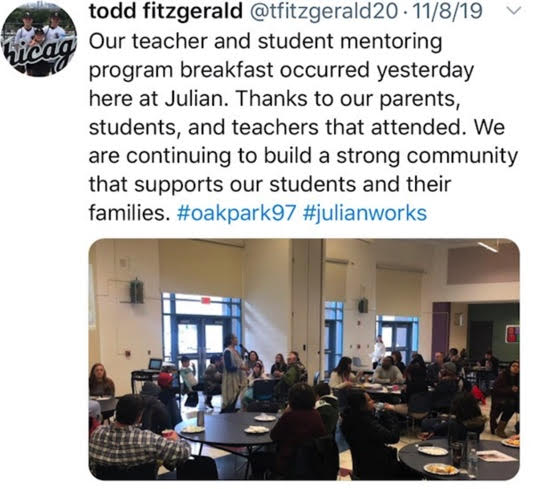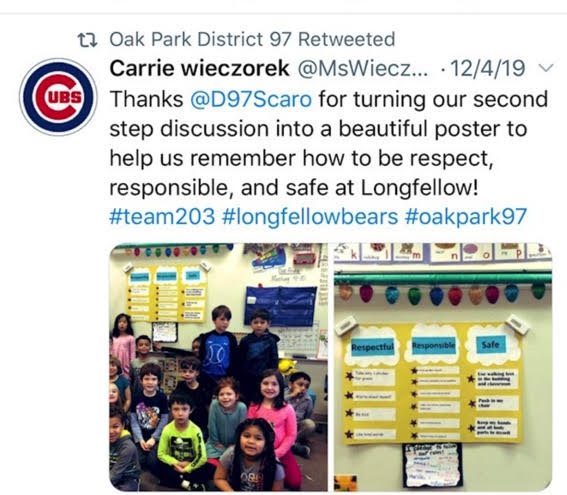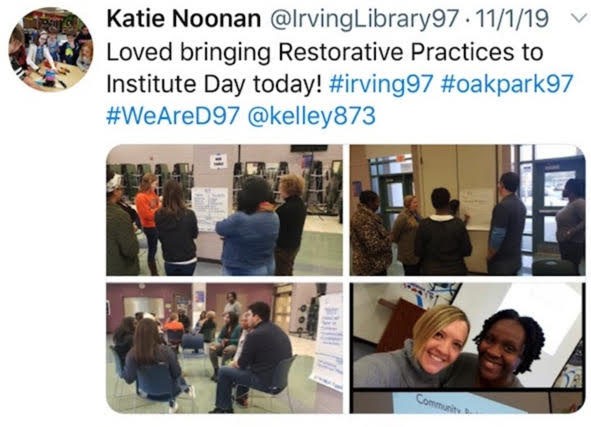The word discipline in connection with schools has such a negative connotation. The long history of shame, punishment and racism has interfered with the very purpose of schools – to help young people learn and grow. District 97 is reclaiming and redefining discipline to better align with our mission and vision of what it means to be educators of students. We are making systemic shifts away from punishment to a mindset of preemption and restoration.
As a district we have made a number of changes aimed at long-term, systemic change. Just a few of these changes are explained below.
We look forward on sharing more about these initiatives and our progress as the year progresses.
Sincerely,
Dr. Carol Kelley
District 97 Superintendent
Hiring Four Culture and Climate Coaches
 The district now has four full-time coaches to work with students and teachers to support the systemic change we seek. One current example of their work is training the entire sixth grade at one of the district’s middle schools in the process of restorative justice. Part of this process includes conducting regular “restorative circles” or "grade-level/cross-grade level circles," which supports the development of relationships in the classroom and across our schools, leading to improved behaviors.
The district now has four full-time coaches to work with students and teachers to support the systemic change we seek. One current example of their work is training the entire sixth grade at one of the district’s middle schools in the process of restorative justice. Part of this process includes conducting regular “restorative circles” or "grade-level/cross-grade level circles," which supports the development of relationships in the classroom and across our schools, leading to improved behaviors.
 "Our culture and climate coaches are providing direct support every day to our teachers and PBIS teams, helping to build their knowledge, skills, and practices around positive behavior supports," said Carrie Kamm, senior director of equity. "Our teams are learning how to apply an inquiry lens to address how our schools can best support our students' social-emotional and behavior needs."
"Our culture and climate coaches are providing direct support every day to our teachers and PBIS teams, helping to build their knowledge, skills, and practices around positive behavior supports," said Carrie Kamm, senior director of equity. "Our teams are learning how to apply an inquiry lens to address how our schools can best support our students' social-emotional and behavior needs."
Training for Educators about Implicit Bias and Systemic Racism
During the 2018-19 school year, the schools facilitated two trainings focused on implicit bias. The first session focused on developing a foundational understanding of implicit bias, connecting that understanding to student and staff lived experiences, and engaging in circle discussions to share reflections and learning. The second session focused on staff gaining a better understanding of their specific biases, understanding how to navigate systems and thinking, and using classroom tools and strategies to address how bias impacts student experience.
 During the current 2019-20 school year, employees new to the district participated in a professional learning session on exploring bias this fall. The culture and climate coaches, PBIS coaches and the district’s Diversity Council are designing a training exploring how bias impacts student discipline. Additionally, our instructional coaches are working with Zaretta Hammond. The staff members are bringing what they are sharing with the full staff during our full day training days (Institute Days).
During the current 2019-20 school year, employees new to the district participated in a professional learning session on exploring bias this fall. The culture and climate coaches, PBIS coaches and the district’s Diversity Council are designing a training exploring how bias impacts student discipline. Additionally, our instructional coaches are working with Zaretta Hammond. The staff members are bringing what they are sharing with the full staff during our full day training days (Institute Days).
New Student Handbook
 The district has been working on the new student handbook this year and will fully put it into use during the 2020-21 school year. The handbook includes using restorative approaches to teach effective behavior, applying progressive discipline that takes into account the whole child, using a trauma-informed lens, and ensuring that students are treated fairly and without discrimination.
The district has been working on the new student handbook this year and will fully put it into use during the 2020-21 school year. The handbook includes using restorative approaches to teach effective behavior, applying progressive discipline that takes into account the whole child, using a trauma-informed lens, and ensuring that students are treated fairly and without discrimination.
New Dress Code
A study by the National Women’s Law Center found that Black girls across the country miss out on important time in the classroom because of what they are wearing or their hair style or makeup. The study found that strict dress codes do nothing to protect girls or their classmates’ learning – they only interrupt their educations. The impact of strict dress codes on Black boys, transgender students and all students is also confirmed throughout the country, so District 97 decided to eliminate this barrier to our students’ education. The following language from the new dress code sets the tone for this revised policy.
The primary responsibility for a student’s attire resides with the student and their parent(s) or guardian(s). The School District is responsible for seeing that student attire does not interfere with the health or safety of any student, that student attire does not contribute to a hostile or intimidating atmosphere for any student, and that dress code enforcement does not reinforce or increase marginalization or oppression of any group based on race, sex, gender identity, gender expression, sexual orientation, ethnicity, religion, cultural observance, household income, or body type/size. Any restrictions to the way a student dresses must be necessary to support the overall educational goals of the school and must be explained within this dress code.
Given that the shift in how the district addresses discipline is new, complete data is not yet available but anecdotally we have heard about positive changes in our schools.
"During our annual student focus group sessions, when asked about the revised student appearance policy, students gave positive reviews of the updated dress code," said Felicia Starks Turner, senior director of student and administrative services. "Particularly, middle school students shared an appreciation for having more flexibility in their clothing choices, like wearing a hat or a hooded sweatshirt in the classroom. Students also shared this this is a topic being discussed among their peers, noting that they haven't received as much attention from teachers and administration for dress code violations this year."
